






Experience
















Experience









program was designed for motivated individuals who have a vision for their business and a sound strategy yet lack the funds to implement their plans.
"This program is a testament to AgWest's dedication to supporting the future of agriculture." said Bill Perry, CEO and President of AgWest. "Investing in new producers is an important initiative at AgWest."
Learn more about 2024 New Producer Grant winners:
Luis Arredondo is a first-generation American whose career began with the US Marine Corps. After two tours of duty, Luis became interested in agriculture during college. He aims to develop a program that will provide internship opportunities for students studying Agriculture and Viticulture in coordination with Allan Hancock College and Rockfront Ranch. The objective is to give students experience in orchard management, harvest operations, and sustainable practices. This grant will help fund resources needed to cultivate Blue Elderberry, a drought-tolerant California native plant.
Marah Meek, a grant recipient from Kern County, California, is deeply rooted in her community. She is a founding member of Fortitude Community Farm School, focusing on sustainable farming practices and educational outreach. She believes that by supporting local businesses and initiatives, we can foster a thriving, resilient community for all. These grant funds will be used for a cargo trailer that will help transport unsold food from farmers markets and direct it through various programs that support school districts and students.

Zachary and Annie Paschall own and operate Deuteronomy 6 Farm, a 15-acre walnut, apple, honey, and egg farm. The farm has been a place of healing and has helped Zach in his recovery from life-altering injuries during his third combat deployment in Afghanistan while serving as a U.S. Navy SEAL. Grant funds will purchase an updated well pump and a roaster for value-added organic honey-roasted walnuts. The couple provides guests with a special farm-to-table experience during harvest while giving back by providing alternative industry training in farming to those in need.
Scan the QR code below for more information about the 2025 New Producer Grant, including program guidelines, eligibility criteria and application forms.




















In a world that often prioritizes speed over substance, there remains proof that good things, and excellent taste, take time. D.O. Cava and Jamón ConsorcioSerrano are two such treasures, each representing a unique blend of Spanish tradition and taste created with time and perfected over centuries.
Cava has earned its place among the world’s finest sparkling wines, yet it remains wonderfully versatile. Whether paired with a simple salad, a casual meal or a celebratory toast, Cava brings a touch of elegance to every occasion. What makes Cava de Guarda Superior unique is that it is produced using the traditional method where secondary fermentation occurs in the bottle. This meticulous process, lasting a minimum of 18 months, is carefully overseen by the D.O. Cava regulatory body, ensuring that each bottle upholds the highest standards of quality and authenticity. Made from organic vineyards that are over 10 years old, Cava de Guarda Superior reveals its craftsmanship with every pour. As the delicate, harmonious bubbles rise to the surface, you can truly appreciate the time and care it took to perfect them! Similarly, Jamón ConsorcioSerrano is more than just a drycured ham. This exquisite product is made using traditional curing


FOOD FOR THOUGHT
A letter from our Managing Editor
TASTING SPOT
Move to the beet
AMUSE-BOUCHE
California Lavender Honey Farm; Firstfruits Farm SLO; Marin’s Vineyard; Lasagna Love; Kula Hawaiian Kitchen; Bubbles & Tea Coffeehouse; Thai Easy Bowl; Kiler Ridge Olive Farm’s olive oil cake recipe
EASTER CELEBRATION
The local and sustainable way
IN SEASON
Spring cleaning recipes
CARING FOR THE COOP
Raising backyard chickens
SAVOR SANTA MARGARITA
Food map
methods which takes a minimum of 12 months to deliver a delicate and rich flavor. Each production is upheld to the rigorous standards of the Consorcio del Jamón Serrano Español, which ensures that every piece of Jamón ConsorcioSerrano bearing the seal is of exceptional quality. Like Cava, Jamón ConsorcioSerrano is not merely an accompaniment to festive tables; it is a versatile delight that can elevate everyday meals with its complex flavors and delicate texture. Both Cava and Jamón ConsorcioSerrano are perfect examples of how time-honored craftsmanship, underpinned by the European Union’s commitment to quality and tradition, creates products that are unmatched in their category. They are not just crafted in Spain; they are perfected by time, offering a taste of excellence that is both accessible and extraordinary. Whether enjoyed on a special occasion or as part of your daily life, Cava and Jamón ConsorcioSerrano bring the best of Europe to your table.

OF
A family farm passed down
PERSPECTIVE
Market to market
FEAST
Bagel brethren
SIPS
Sip and stretch
BUSINESS IMPACT
State of Cayucos
BACK OF HOUSE
The taste of Mardi Gras
LET’S EAT
An Etto Pastificio cookbook
Radish vodkatini
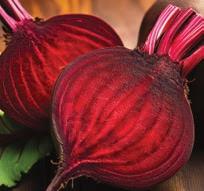


Chai Latte Olive
Spicy Rhubarb Jam
Grilled Spatchcock Chicken with Herb Marinade
Asparagus and Lemon Risotto with Parmesan Crisps
Pantry Clean-Up Casserole
Sun Dried Tomato and Pesto Egg Quiche
Aglio e Olio with Crispy Fried Capers




A PASO ROBLES GETAWAY PROMISES PEAK CALIFORNIA: Pacific sunsets, Michelin-starred dining, more than 300 wineries, and icons like Hearst Castle and Sensorio. Midway between Los Angeles and San Francisco, this free-spirited small town is shaped by innovators and artists drawn to local vineyards, farms and wildflower-dotted foothills.





All natural pork, beef and lamb raised sustainably and humanely by a community of more than 600 independent family farmers and ranchers to produce the highest quality meat.




100% Certified Humane ®
No antibiotics or added hormones—EVER
No crates—EVER
Raised outdoors and in deeply bedded pens
100% vegetarian feeds





The beginning of spring has always felt like a clean slate, a true fresh start. More so, I’d argue, than the days immediately following the climactic hustle and bustle of end-ofyear parties and celebrations. With the feasts, chaotic shopping and cross-country travel behind us (for the most part), now feels like a good time to truly reflect on 2024.


PUBLISHER
It was a year that brought about a lot of change — some good, some painful. Heart on my sleeve, it’s difficult for me not to file 2024 as categorically “bad” in light of the unexpected loss of a close friend. But as the months march on, this period of transition into a new normal is one of growth and meaning. Rekindling connections with long-time friends and saying “yes” to more experiences out of my comfort zone (did you catch our special digital issue??) have allowed me to be sanguine about this new year. I’m hopeful that no matter your transition in life — and we all go through it — you can find some comfort in memories of what was and optimism about what lies ahead.
For us here at Edible San Luis Obispo, we are finding new ways to think outside the proverbial box by challenging ourselves to think in different directions. The pages of this particular issue focus on the transi-
Shop Talk LA, Inc.
Gail Cayetano Classick gail@edibleslo.com
MANAGING EDITOR
Aja Goare
aja@edibleslo.com
ART DIRECTOR
Shay Swetech
WRITERS
Katy Budge, Christian Camacho, Candice Custodio, Aja Goare, Jonathan LaFerrara, Casey Nauta, Renee Roragen, Annie Secrest, Zoe Elliott Shaw, Brian Terrizzi
PHOTOGRAPHERS
Blake Andrews, Richard Fusillo, Stephen Heraldo, Sarah Kathleen, Hugo Martinez, Lori Rice, Gennan Shippen, Ruby Wallau
tions all around us: coming of age and charting one’s course, passing down the family farm, transforming an old space into something new, the evolution of a coastal town, and — of course — the literal change of seasons itself, along with all the delicious ingredients that it shifts into focus. I mentioned earlier that the festivities were nearly done; that’s because Mardi Gras is nigh and a San Luis Obispo restaurant marries tradition with flavor for an authentic celebration. Get your appetite ready. Chef Rachel Ponce has a special offer for us — a delicious dinner that accomplishes some spring cleaning. It’s a two-for-one!
Looking ahead, the Winter 2025 publication will mark Edible San Luis Obispo’s 50th issue. It’s an exciting milestone that attests to the dedication of our team, the incredible support of our community and the resilience of these pages through the many transitions over the years. More to come on this and a proper celebration is in the works. But for now, I’m focused on this moment, right now, and embracing what spring has to offer.
Be well, Aja Goare

DESIGN CONSULTANT
John Miller
ILLUSTRATORS
Dyna Beach, Anna Takahashi
RECIPE DEVELOPER
Rachel Ponce
SOCIAL MEDIA
Stephen Heraldo, Tessa Miller DIGITAL EDITOR Dustin Klemann
SALES
Uli Billington
GENERAL INQUIRIES
info@edibleslo.com
By Aja Goare
Semi-sweet orbs with gem-like tones of purple, red and yellow, the beets is a versatile root vegetable that can gin up any salad, Buddha bowl or fresh juice. Spring is the perfect time to plant beets, which will be prime for picking in just two months from seeding.
The name “beet” comes from the Celtic word for “red,” but modern cultivars span the rainbow of colors. Golden beets, in particular, present a beautiful sunny shade of yellow. This variation has been planted since the 1940s but available since the 1800s, though few planted it because the red beet was the preferred color. Golden beets are well liked for their sweet, mild taste.
Beets are semi-hardy, meaning they can withstand a light frost. In California, they tend to weather the winter conditions underground. Beet seed is actually categorized as a fruit or seed ball with several embryos.
The spherical root vegetable is believed to have originated in the Mediterranean. When early civilizations first used beets, it was primarily for the stems and leaves. The Greeks called the leaves teutlon because the leaves resembled tentacles. The Romans were the first to cultivate the plant for its root and also used the beet medicinally, as well as in cooking.
Today, three basic varieties of the plant are grown for different uses: hard beets are
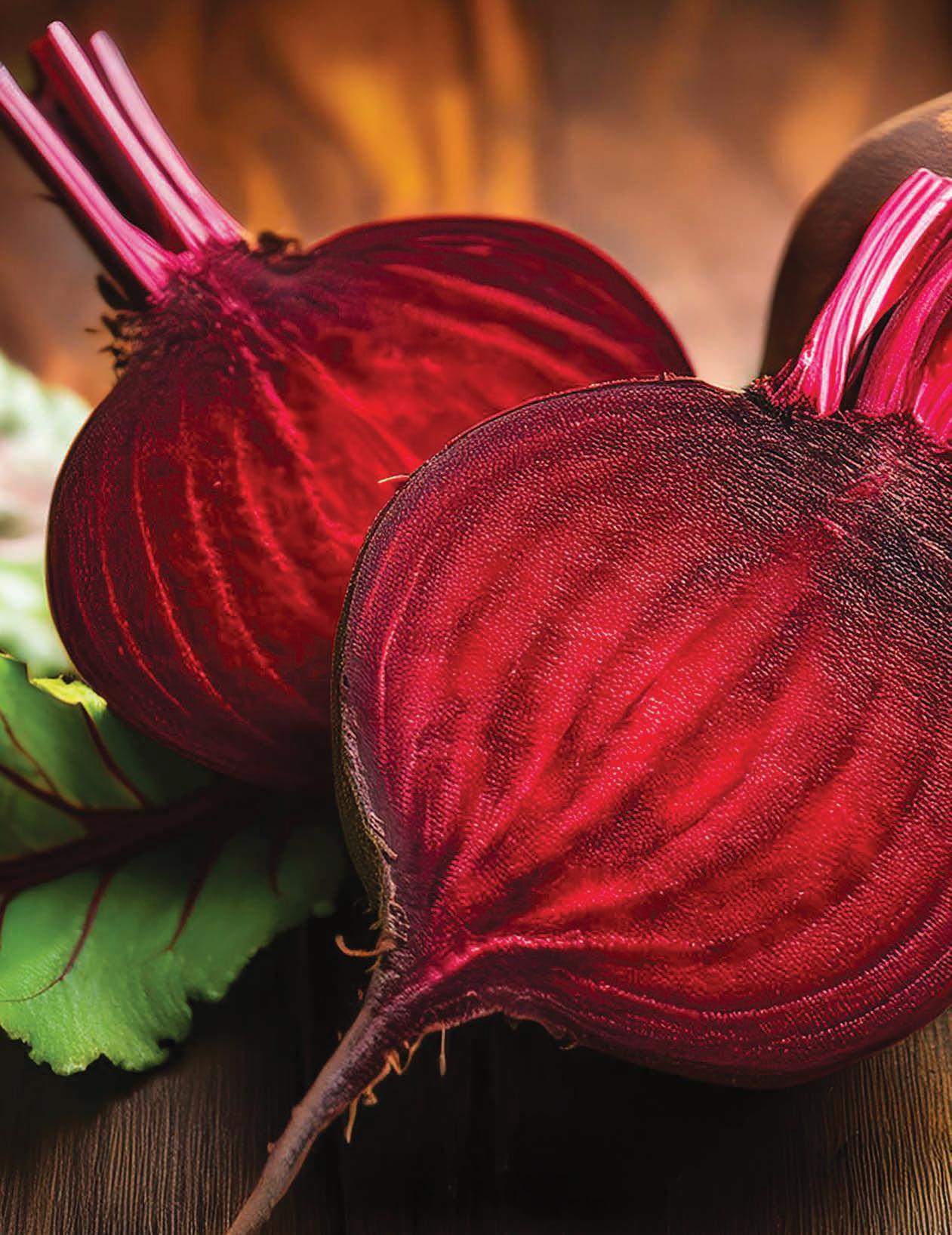
grown specifically for their leaves; other beets are grown for their bulbous root, with edible leaves (with varieties in white, yellow and red roots); and sugar beets are produced for making sugar from the long, thick root. The first sugar beets contained only about 6 percent sugar but manipulation of the plant over the years has led to a 20 percent sugar content, which is used to make white sugar.
Beets contain a significant amount of vitamins A and C, as well as calcium, iron, phosphorus, potassium, protein and carbohydrates. Beets are also high in folate, dietary fiber and antioxidants. The greatest amount of nutrients is gained when beets are consumed raw. They’re a popular addition to salads with goat cheese and walnuts, which make for a rich, sweet and savory meal. Often beets are juiced for a fresh, healthy drink. And they can be roasted and enjoyed in a bowl alongside other roasted root veggies and a steamy grain. They are famous as pickles and in the Eastern European soup called borscht.
The vibrant hues that make beets so enticing in salads can prove disastrous for clothing that gets stained while peeling and cutting the juicy globe. But for some, that’s less of a problem and more of an art form. Beets have long been used as a natural dye for clothing and linens. Thus, this is truly a transitional ingredient — worthy as both food and fashion.




By Renee Roragen
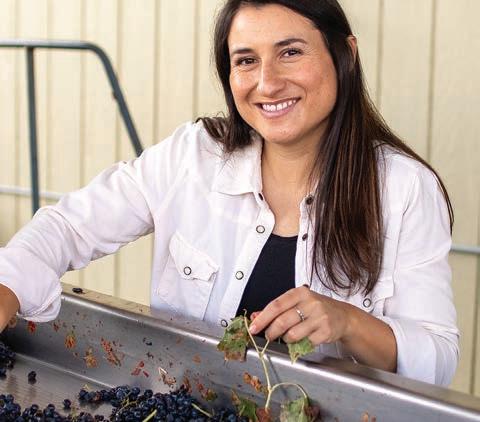
Established in 1999 with the planting of vines, Brenda and Duane Wolgamott named their family property Marin’s Vineyard after their 7-year-old daughter, who is now the winemaker. Originally focused on selling grapes, the family began making small batches of wine in 2004. After earning a degree in wine and viticulture at Cal Poly, Marin became the head winemaker in 2014. She’s grown viognier, cabernet sauvignon and Malbec grapes, and crafts wine made almost exclusively from the vineyard’s own fruit. The Wolgamotts recently relocated the tasting room from their hometown of Lockwood to a downtown space in Atascadero that’s equipped with an inviting outdoor area to accommodate larger groups. The move has brought fresh energy to their winemaking tradition.
5983 Entrada Avenue in Atascadero. marinsvineyard.com | @marinsvineyard

Firstfruits Farm SLO is an entirely volunteer-run nonprofit dedicated to combating food insecurity in San Luis Obispo County, where one in five residents experiences risk of hunger. Since its establishment in 2013, this eco-conscious farm has grown over 30 varieties of fruits and vegetables using organic, sustainable practices, while offering harvested crops freely to community members in need. The orchard grows seasonal crops from nectarines, plums and apples to tomatoes, peppers and hearty root vegetables. The operation is rooted in the simple idea of bringing first-choice produce to food pantries. The farm has grown into a vital community resource, fueled by volunteers of all ages and backgrounds. For planting, harvesting or helping with farm care, volunteers are always needed and welcome to join the mission of caring for both the earth and neighbors in need.
firstfruitsslo.org | @firstfruitsfarm_slo

Started by Artem and Tatiana Sorokina and supported by their two sons, the family-run California Lavender Honey Farm combines sustainable agriculture with wellness and education. Known for its honey and lavender, candles and natural skin care products, the farm also serves as an immersive educational platform. Guided tours offered year-round delve into sustainability practices, the world of bees and beekeeping, and the therapeutic benefits of lavender and honey. Scheduled weekend farm events include yoga, sound healing, the popular CREATIVI-TEA sessions (a tea-based twist on arts and crafts) and visits to the farm’s Bee Museum. Open on weekends by appointment.
6380 Hawk Ridge Place in San Miguel. californialavenderhoneyfarm.com @my_california_farm

Bubbles & Tea Coffeehouse in Nipomo was born from a shared vision of Maricruz Sanchez and her mother, Reynalda Sanchez, to bring the community together without a long drive for quality coffee, evening social events or a place to relax over a glass of wine. Maricruz, whose background includes years as Wine Club Coordinator at Laetitia Vineyard & Winery, brought her passion for both coffee and wine to the business, where patrons enjoy not only crafted lattes but also sparkling wines for celebrating life’s everyday moments. The menu reflects a blend of tradition and the family’s entrepreneurial spirit, with dishes like homemade tamales that harken back to their early days of selling them door-to-door.
338 West Tefft Street, Suite B in Nipomo. bubblesandtea.co | @bubblesandteacoffeehouse


Kula Hawaiian Kitchen (or KHK), owned by husband-and-wife team Chris and Ayako Williams, opened in August as part of their already established Kula Vineyards & Winery in Atascadero. Inspired by the Williams’ time living in Hawaii, KHK recreates classic island comfort food, offering from scratch-made dishes like teriyaki chicken, spam musubi, kalbi short ribs and the favored Kalua pork, which is prepared by wrapping the pork in banana leaves and smoked for hours until tender and falling apart. Each element of their dishes, from sauces to seasonings, is crafted onsite. The owners plan to introduce beer brewed inhouse in 2025.
6200 El Camino Real in Atascadero. order.kulahawaiiankitchen.com | @kulahawaiiankitchen
Opened near the end of 2024, Thai Easy Bowl is the latest concept by owner Anek Thammuenyong who founded Thai BBQ & Combo in Paso Robles and Thai Elephant in San Luis Obispo, Pismo Beach, Morro Bay and Atascadero. The new venture focuses on a slimmed down menu of Thai street food, from pad krapow moo (ground pork sautéed in chili garlic sauce and served with steamed rice and an over easy egg) to khao man gai (seasoned steamed chicken in a Thai chili sauce). Round out the meal with the mango sticky rice dessert.
13 Santa Rosa Street in San Luis Obispo. thaieasybowl.com
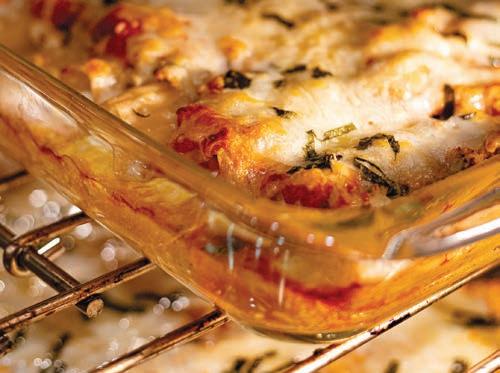
A California nonprofit conceptualized in the early days of the pandemic, Lasagna Love has grown into an international movement delivering homemade lasagnas to anyone in need — no questions asked. The San Luis Obispo County chapter began in October 2020 and is led by Regional Director Bethany Williams. “If you got your heart broken or lost your job, or don’t know how to cover rent, you should definitely have some lasagna,” says Bethany. Volunteer lasagna makers coordinate with recipients to meet dietary preferences and arrange doorstep deliveries, all free of charge. Today, Lasagna Love has chapters in every U.S. state, as well as in Canada and Australia, delivering thousands of lasagnas weekly while fostering kindness and community connection. lasagnalove.org | @wearelasagnalove
Enjoy this delectable, non-dairy olive oil cake by Alexandra Fletes of Kiler Ridge Olive Farm. It calls for using Kiler Ridge’s Coratina, the farm’s most buttery variety of olive oil, a fat that is an easy substitute in recipes calling for cooled, melted butter.
16
1 tablespoon plus 1⅓ cups extra virgin olive oil (Kiler Ridge Coratina recommended)
2 cups all-purpose flour
½ teaspoon baking soda
½ teaspoon baking powder
2 teaspoons ground cardamom
1 tablespoon ground cinnamon
½ teaspoon ground nutmeg
2 teaspoons ground ginger
1½ teaspoons sea salt
3 large eggs
1¼ cups coconut cream
1 cup sugar
1 teaspoon vanilla extract
Powdered sugar, for dusting
Chai spice, for dusting

SUNDAY, MAY 4
We invite readers to join fellow Edible community members at Kiler Ridge Olive Farm to celebrate spring with brunch and an olive farm tour.
JOIN US! ediblesanluisobispo.com/ kilerridgebrunch

STEP 1
Prepare a 9-inch springform or Bundt pan by lightly coating with up to 1 tablespoon olive oil and lining bottom with parchment paper.
Preheat oven to 350 degrees F.
In large bowl, whisk together flour, baking soda, baking powder, ground spices and salt.
STEP 2
In medium bowl, place eggs, coconut cream, 1⅓ cups olive oil, sugar and vanilla. Use mixer to beat together until light and creamy, about 5 minutes


STEP 3
Add wet ingredients to dry and mix on low speed until well combined. Pour batter into prepared pan and bake for 1 hour, or until toothpick inserted into cake comes out dry. Let cool. Carefully remove cake from pan. Dust with powdered sugar and chai spice.

Handcrafted, ethically sourced chocolate bunnies, eggs and assorted truffles by Mama Ganache Artisan Chocolates 1445 Monterey St, San Luis Obispo mamaganache.com @mamaganachechocolate
All from SLO General Store Eco-kids natural beechwood colored pencils
Eco-kids egg coloring kit made with organic fruit and vegetable extracts
Flower child sunglasses The ABCs of SLO County Yarn bunny
Woven straw basket
3845 S Higuera St, San Luis Obispo slogeneralstore.com @slogeneralstore
By Chef Rachel Ponce :: Photography by Hugo Martinez
A wealth of produce begins to emerge at markets in the spring, which is exciting for cooks — whether it’s your profession or not. Fresh greens and vibrant flowers can be used to adorn plates in both restaurants and homes. These recipes showcase flavors of the season with a touch of warmth to ease the transition from winter to spring.

4 cups (about 1 pound) rhubarb, rinsed and chopped into ½-inch pieces
1 bunch fresh mint leaves, chopped
2 cups granulated sugar
¼ cup water
1 tablespoon lemon juice
1 teaspoon ground ginger, or
1 tablespoon fresh ginger, grated
½ teaspoon cinnamon
¼ teaspoon cayenne pepper, or adjust to taste
¼ teaspoon salt
¼ teaspoon allspice or cloves for additional warmth (optional)

STEP 1
Combine all ingredients in large pot and cook over medium heat, stirring occasionally to help sugar dissolve.
Once mixture starts to boil, reduce heat to medium low. Let simmer 20–30 minutes, stirring frequently. As rhubarb breaks down, mixture will thicken.
To check if jam is ready, place small spoonful on a cold plate and let it sit for 1 minute. Run a finger through it; if it holds its shape and wrinkles slightly, it’s ready.
If it is runny, continue simmering and check every 5 minutes.
Place chicken, breast side down, on cutting board. Using kitchen shears or sharp knife, cut along both sides of backbone to remove it. Flip chicken over and press down firmly on breastbone to flatten. If needed, a mallet can be used to help break breastbone. Pat chicken dry with paper towels and season generously with salt and pepper on both sides.
STEP 2
Prepare marinade: In bowl, whisk together all marinade ingredients. Place spatchcocked chicken in large resealable plastic bag or shallow dish. Pour marinade over chicken, ensuring it is well coated. Seal bag or cover dish. Refrigerate at least 1 hour, or up to 8 hours for deeper flavor.
STEP 3
Preheat grill to medium high heat, between 400 and 450 degrees F.
This season of renewal can be summed up in one word: fresh. This recipe highlights fresh herbs that can be grown window side at home or in a small garden. Or, dried herbs will work just fine in this dish (note: They have a stronger, deeper flavor than fresh herbs).
Serves 4
1 whole chicken, about 3–4 pounds Salt and pepper, to taste
For herb marinade:
¼ cup olive oil
Juice of 2 lemons
Zest of 1 lemon
4 cloves garlic, minced
2 tablespoons fresh rosemary, chopped, or 1 tablespoon dried
2 tablespoons fresh thyme, chopped, or 1 tablespoon dried
1 tablespoon Dijon mustard
1 teaspoon honey
Red pepper flakes, for a kick
If using a charcoal grill, set up for direct heat. Remove chicken from marinade and let any excess drip off. Discard marinade. Place chicken skin side down on grill and cook about 15–20 minutes or until skin is crispy and golden brown. Let chicken rest for 10 minutes. Carve chicken and use Spicy Rhubarb Jam (recipe on previous page) for a delicious dipping sauce.
Asparagus is one of the first vegetables that are ready when spring arrives. The audible snap of the stems during prep is deeply satisfying, and the zest of lemon energizes these flavorful bites in this dish. The creamy, rich risotto warms the body from the inside out.

Serves 4
For Parmesan crisps:
1 cup grated Parmesan cheese
Freshly cracked black pepper (optional)
For risotto:
4 cups vegetable or chicken broth
2 tablespoons olive oil
2 tablespoons butter
1 small onion, finely diced
2 cloves garlic, minced
1 cup uncooked Arborio rice
½ cup dry white wine
1 teaspoon salt
1 bunch fresh asparagus, trimmed and cut into 1-inch pieces
Zest and juice of 1 lemon
½ cup grated Parmesan cheese
Fresh parsley for garnish

STEP 1
Prepare Parmesan crisps: Preheat oven to 400 degrees F. Line baking sheet with parchment paper. Spoon 1 tablespoon mounds of grated Parmesan cheese onto parchment paper, a few inches apart.
Optionally, add freshly cracked black pepper over mounds. Bake for 5 to 7 minutes or until cheese is melted and golden. Let cool before removing from parchment paper.
STEP 2
Prepare risotto: In medium saucepan, heat broth over low heat. In large skillet or saucepan, heat olive oil and butter over medium heat. Add diced onion and cook until translucent, about 3–4 minutes.
Stir in garlic and cook 1 minute until fragrant. Add in Arborio rice and toast, about 1–2 minutes, stirring frequently. Pour in white wine and cook until mostly absorbed.
STEP 3
Begin adding warm broth to rice 1 ladle at a time, stirring frequently. Wait until liquid is mostly absorbed before adding more. Continue this process for about 18–20 minutes, until rice is creamy and al dente. In last 5 minutes of cooking, add asparagus pieces to risotto and stir in. Finish with salt, lemon juice and zest. Serve in bowl, and top with extra asparagus and Parmesan crisps. Garnish with parsley.
The tradition of spring cleaning usually involves reorganizing the junk drawer and shuffling out tattered clothing, and this recipe applies that practice to the pantry. Decluttering all those canned goods and extra ingredients offers a fresh – and scrumptious – start.
2 cups cooked grains (rice, quinoa, pasta or couscous)
1 15-ounce can beans (black, chick peas or kidney), drained and rinsed
2 cups vegetables* (fresh, frozen or canned)
1 cup cooked protein (shredded chicken, ground beef, sausage or tofu)
1 10½-ounce can cream of mushroom soup or cream of chicken soup
½ cup vegetable or chicken broth
1 teaspoon garlic powder, or 2 cloves fresh garlic, minced
1 teaspoon onion powder
1 teaspoon salt
1 teaspoon black pepper
1 teaspoon Italian seasoning
1 tablespoon olive oil
1 cup shredded cheese (Cheddar, mozzarella or whatever is available)
1 cup breadcrumbs, or crushed crackers
Fresh herbs, for topping (optional)
*Frozen mixed vegetables, canned corn or peas, or fresh bell peppers, zucchini or spinach
STEP 1
Preheat oven to 350 degrees F. In large mixing bowl, combine cooked grains, beans, vegetables and cooked protein. Mix well.
STEP 2
In separate bowl, mix together cream soup, broth, garlic powder, onion powder, salt, pepper and Italian seasoning. Pour sauce over grains and vegetables mixture and stir until everything is evenly coated.
STEP 3
Grease 9x13-inch casserole dish with olive oil. Spread grains and vegetables mixture evenly in dish. Top with breadcrumbs or crushed crackers, and cheese.
Bake for 25 minutes or until heated through. Top with fresh herbs.

By Annie Secrest
The gentle cluck of backyard chickens is for many San Luis Obispo County residents the sound of nourishment, connection and even companionship.
A backyard bird can produce around 200 eggs per year up until five years of age. The egg production cycle occurs during the warmer, longer days of summer. But chickens aren’t just egg producers — they’re personable, social creatures with charm that can rival household pets. Chef and TV Personality Martha Stewart, an early advocate of backyard flocks, once wrote, “There are so many rewards from raising these birds. You get delicious eggs, and the joy of caring for them is great for you and your family.”
Luckily, sprawling acreage isn’t necessary to embrace a lifestyle with these feathered friends. County code permits residents to have up to 20 chickens, even within city limits. About 10 square feet per bird is ideal to give them space
to scratch, stretch and strut their stuff. As the flock grows, so will their need for space; in return, they’ll reward their keeper with fewer squabbles, healthier feathers and cleaner coops.
The variety of backyard chickens is diverse; some breeds are prized for eggs or meat, others are raised for their sheer beauty, with captivating plumage. Barbara Bullock, a Central Coast poultry expert and member of the Central Coast Feather Fanciers, recommends three egg-laying breeds, which are also “dual purpose” birds that can also be used for meat. They are Orpington, Rhode Island Red and Welsummer. Sourcing chickens from reputable breeders and ensuring they are vaccinated are key, says Barbara, to starting a healthy, thriving flock.
Chickens are highly social animals, so plan to start with at least three, but no more than five. Adding new birds later can ruffle feathers, literally. To smooth the transition, Barbara advises isolating
newcomers for 30 days before introducing them to the flock, using a large dog crate as a temporary “guesthouse.” This gives the fowl time to get acquainted from a safe distance. Raising chickens is a long-term commitment — these intelligent birds can live 14 to 15 years.
They are also natural foragers, delighting in bugs hidden beneath leaves and soil. But their diet benefits from balance; high-quality feed ensures their nutritional needs are met. Those planning to enjoy their eggs should select feed with a particular focus on calcium. Chickens also adore scraps from the kitchen — think cabbage, zucchini or apples — but steer clear of moldy food, which can upset their sensitive stomachs. Snacking on pumpkins and marigolds produces egg yolks with a rich golden hue.
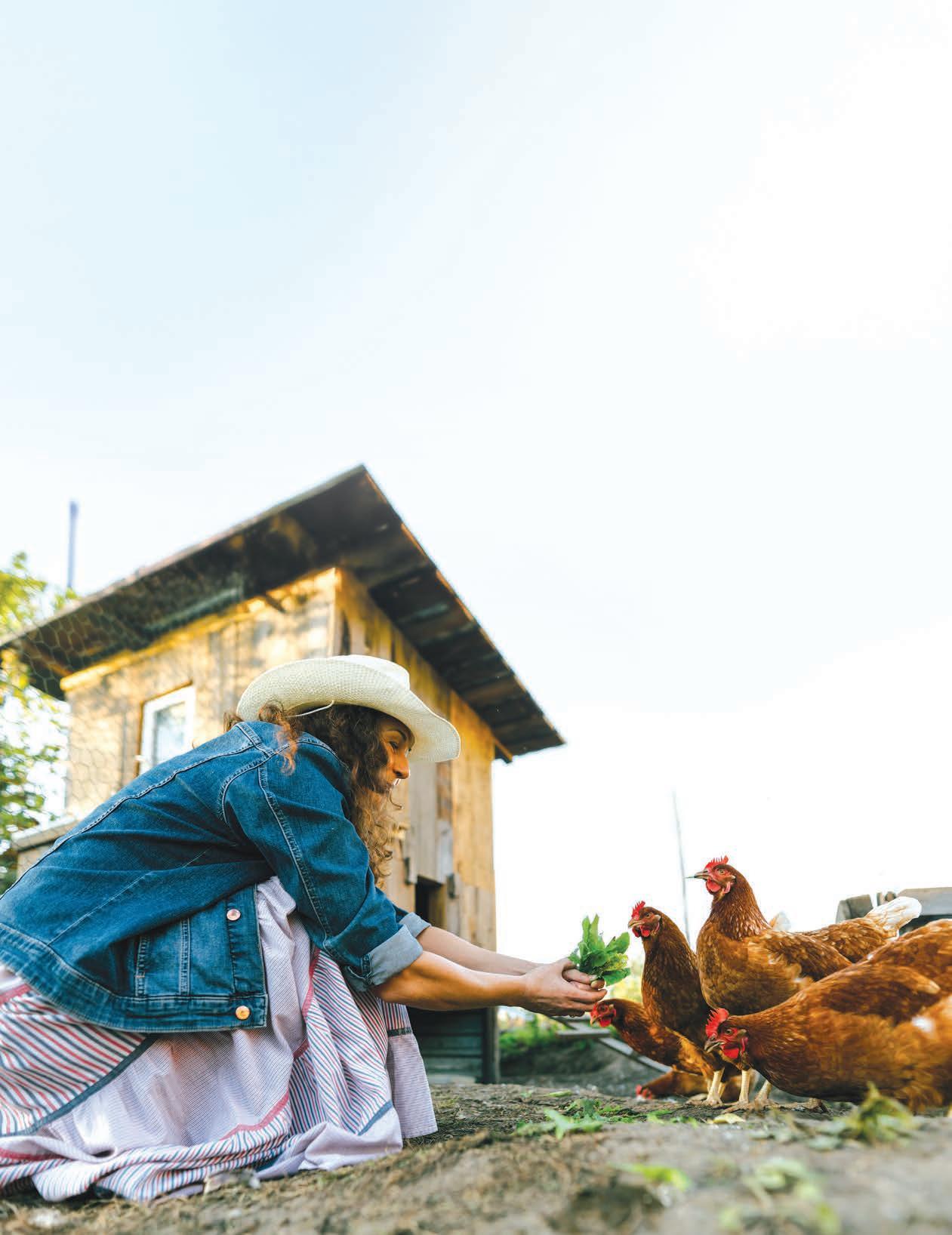
Like any pet, chickens come with their share of challenges. Among the most common threats in SLO County are dogs, which see chickens as prey. Supervise dogs around the flock or keep the two separated. Predators such as raccoons, hawks, cats and coyotes are resourceful and persistent. A well-secured coop is the best defense, with rigid wire like hardware cloth offering better protection than traditional poultry netting. Hawks may swoop from above, so consider sheltered spaces for the flock. The smallest threats — mites, lice and mice, which thrive in dirty enclosures — can be warded off with regular coop cleaning.
The rewards of backyard chickens extend well beyond fresh eggs. Chickens are surprisingly intelligent, with sharp memories and an ability to recognize faces, including that of their owner.
They express contentment with soft, throaty purrs and serve as unofficial yard sentinels, loudly announcing the arrival of strangers. Even roosters, often typecast as noisy, aggressive birds, can be affectionate, offering small “gifts” like twigs or leaves to their humans as a token of goodwill. Local poultry enthusiasts can find guidance and camaraderie through groups like Central Coast Feather Fanciers that promote the art of standard-bred poultry and share knowledge across the community.
New York Times bestselling author and naturalist Sy Montgomery perhaps said it best: “Folks use words like ‘astonishing’ to describe such friendships between people and poultry. What’s more astonishing, though, is not that these birds know so much about their human neighbors, but that we humans know so little about our neighborhood birds.”

1 premade frozen pie shell
8 farm fresh eggs
½ cup heavy cream
¼ teaspoon salt
¼ teaspoon pepper
1 tablespoon olive oil
½ cup onion, diced
2 cloves garlic, minced
4 tablespoons premade pesto
½ cup sundried tomato halves (not oil packed)
STEP 1
Thaw pie shell for 10–20 minutes, until pliable. Meanwhile, preheat oven to 425 degrees F. Prick bottom of thawed pie shell with fork and bake for 10–12 minutes, until lightly golden around edges. Allow to slightly cool while preparing remaining ingredients.
STEP 2
In medium mixing bowl whisk together eggs, heavy cream, salt and pepper.
STEP 3
In skillet over medium heat, place olive oil and sauté onions for 5 minutes, then add garlic and cook for 1 minute more. Spread garlic and onion mixture across bottom of pie shell. Pour in egg mixture. Drizzle pesto over eggs, then arrange tomato halves on top. Bake for 20–30 minutes until mixture is set.
A MORNING DISH TO MAKE WITH YOUR BACKYARD CHICKEN’S FRESH EGGS.

By Zoe Elliott Shaw :: Photography by Blake Andrews
THE LEGACY OF BAUTISTA FAMILY FARMS CONTINUES WITH A NEW GENERATION.
Early one morning in 1988, Apolonia and Manuel Bautista took their produce to the local farmers’ market for the first time. With two boxes of their best squash in tow, they set up for what they did not yet know would be the start of nearly 40 years of market sales.
When the squash sold out, they began selling cherry tomatoes, which also sold out. The Bautistas added to their rotating rainbow smorgasbord peas, green beans, carrots, golden beets, chard, salad mix, cucumbers, blackberries and herbs. Today, Bautista Family Farms produce is widely known around the county for the freshest, high quality and reasonably priced ingredients possible.
The local climate allows the Bautistas to grow and harvest a large range of produce year-round. They practice a core commitment of quality over quantity, harvesting in smaller batches, constantly rotating, turning and nourishing the soil with a variety of vegetables. “We grow it for you to enjoy it,” says Manuel. “I am grateful for the opportunity to farm.”
As Manuel and Apolonia’s family expanded, so did their land; 20 acres became 40 and their business grew, as a result. Over the past decade, the family farm has entered a new era. Manuel and Apolonia are now grandparents and have slowly handed over their operation, experience and management to their son, Jacinto, who has a young family of his own.

Sharing the same passion for growing as his father and possessing a similar calm demeanor, Jacinto finds pride and joy in everyday tasks. Surrounded by the green rolling hills, a warm breeze swirling, he looks out at the farm below the family home. Their dog Havana stands at his feet while his wife tends to their new baby and toddler in the house.
“You take it as it comes,” Jacinto says of the fast moving day-to-day. “I am always thinking about what’s next. Everything must be determined by quality.”
The Bautista crew has experienced the challenges of climate change, faced with property damage and loss during floods. The hoop houses originally used to protect the berries from rain are almost unnecessary due to the hotter extended seasons. “This area is growing, but if we were pushed deeper into the valley, there would be less that we could grow,” Jacinto explains.
They are often shouldered by the balmy warmth of Huasna Valley and experience long growing seasons. “Everything is fresh, handpicked and always changing. We never plant too much of anything. We’ll pick greens for a couple of weeks, and then it’s time for something else,” he says with a lighthearted
shrug before explaining the short cycles of tender greens. “With each new crop, we bring nutrients back into the soil and eliminate the need to add synthetics to the land.”
Achieving this level of quality and output isn’t easy. But the family is committed to their legacy.
“We all know we will work harder if our families are taken care of, so that’s the focus,” Jacinto emphasizes. “We all know family comes first, then work. If you need to leave because your kid is sick at school, just go.”
Thanks to local customers like Brian and Harmony Collins, who established Ember restaurant in 2014, the Bautistas developed a strong local base and now only sell locally. Beyond the demand of the many restaurants carrying Bautista produce, they deliver to 11 markets per week from Cambria to Vandenberg to Santa Maria, plus the farm stand and Halcyon Farms in Arroyo Grande.
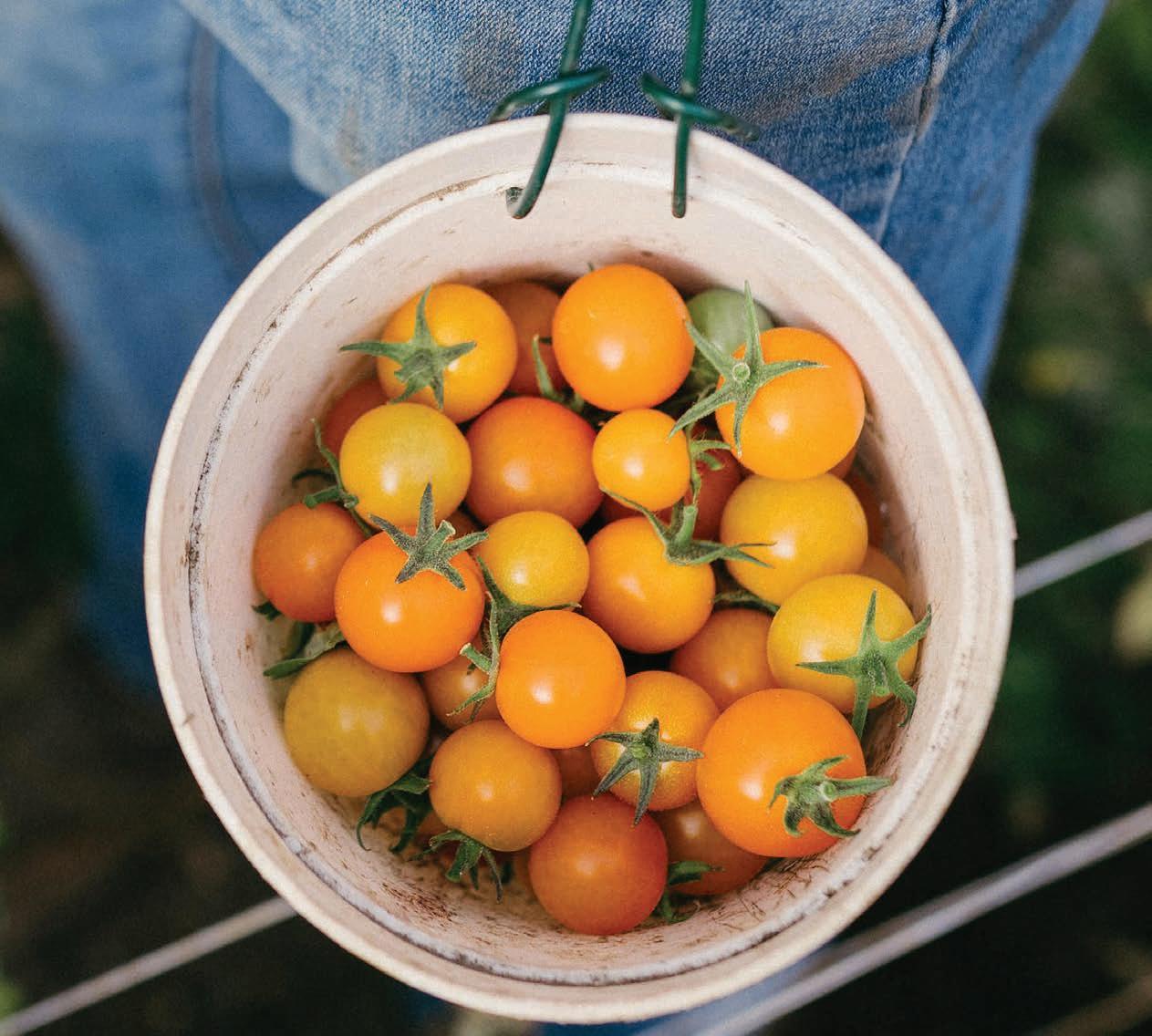
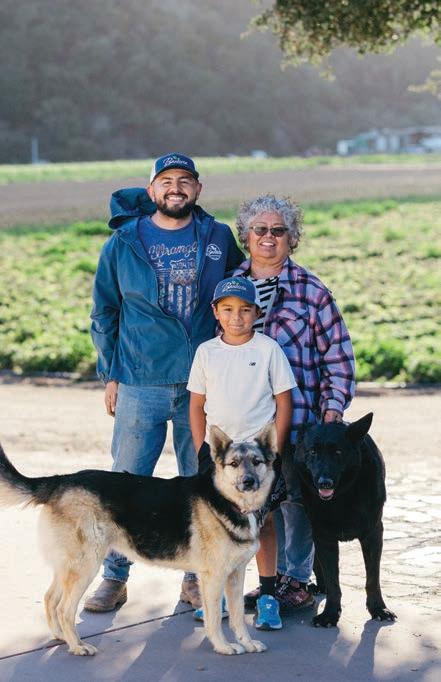



These skilled farmers grow, pick and deliver some of the most affordable and fresh produce around, and supply local school districts with their harvest for school meal programs. Jacinto aims to continue providing the community with quality produce, but beyond him and his commitment, he is concerned with big box stores taking over small business. “If we stop shopping locally, the small farms die,” he warns. “Vons will be fine, so will Costco, but not the local farms. We depend on it.”
By Casey Nauta :: Photography by Gennan Shippen

FARMERS’ MARKETS FUEL OUR COMMUNITIES; WE NEED THE NEXT GENERATION TO GET INVOLVED.
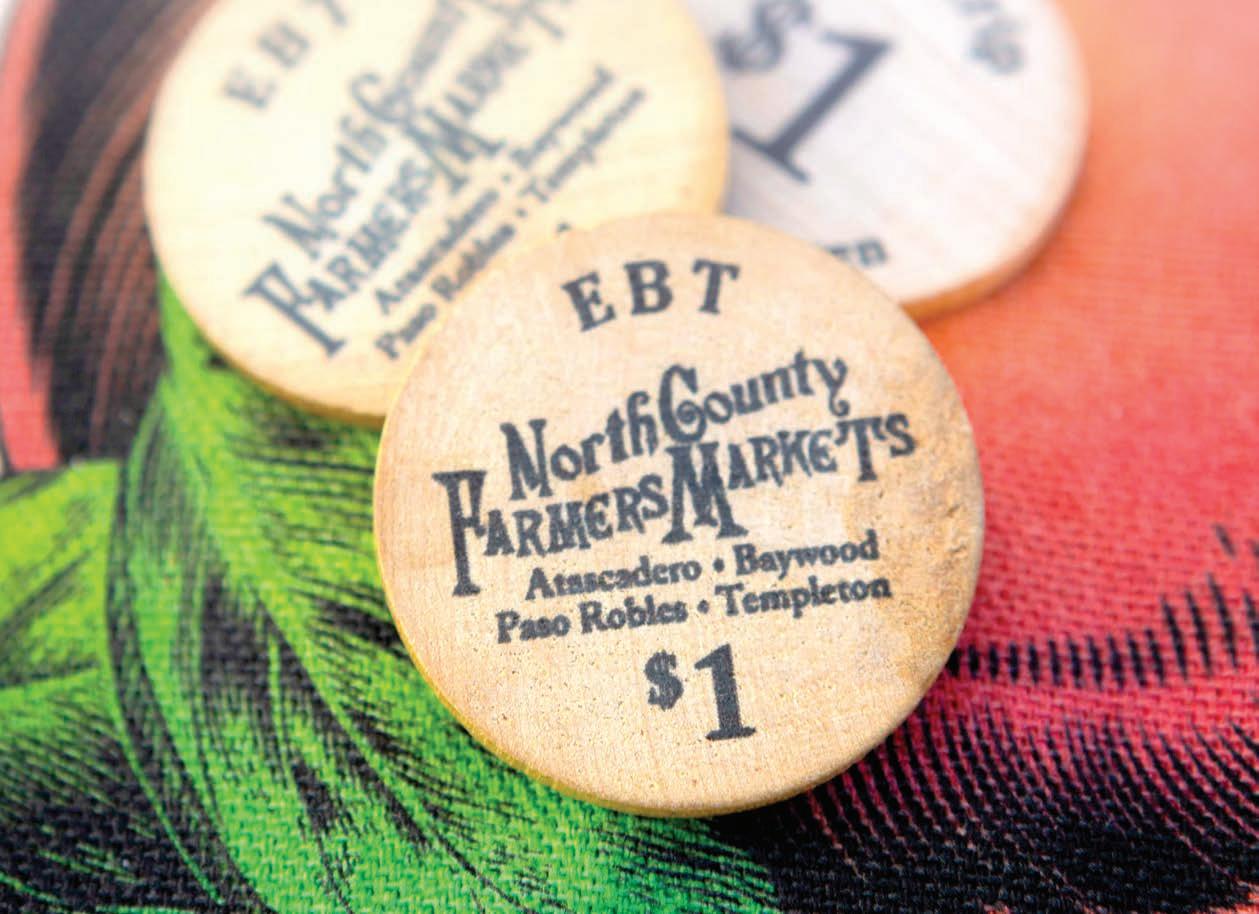

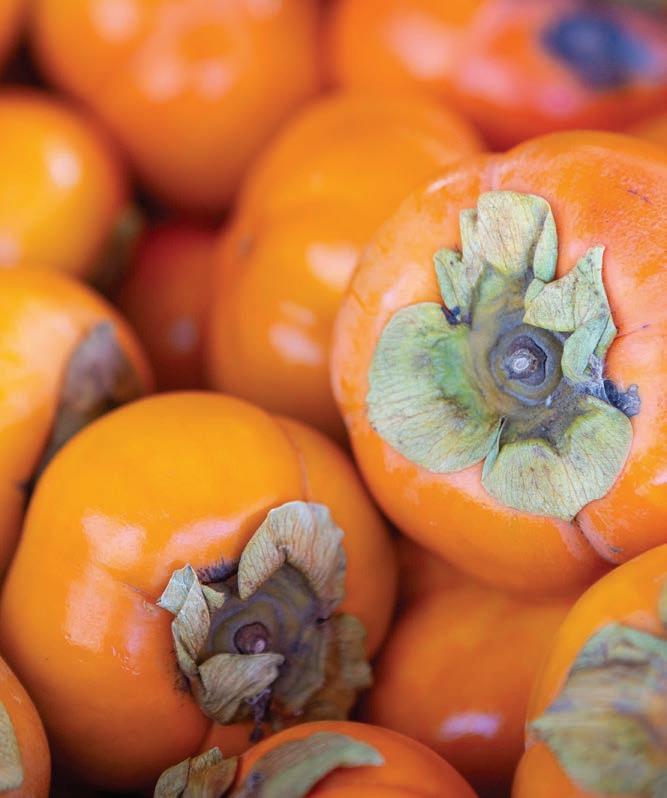
Igrew up on my family farm, Rocky Canyon Farms in Atascadero. My parents began their business from their joint senior project out of Cal Poly in 1990. Since I was a child, my parents have raised beef, pork, chicken for meat and eggs, melons, tomatoes, cucumbers, peppers, winter squash and so much more. I was also a part of 4-H, FFA, rodeo and many other horse groups and activities growing up.
As a graduate of Cal Poly’s class of 2020, I know I’m young as a manager of this association. I’m the eldest of Generation Z — the Zoomers — a generation widely defined as being eternally online. Technology is a big career focus for my generation, not agriculture. But it’s a sector of our economy and our community, frankly, that I feel deserves our time and attention.
I didn’t always plan to work with farmers’ markets. Having grown up tending to crops and feeding the farm animals, my brothers and I always envisioned getting away and charting our own courses. But throughout college, I continued working for my parents and the Santa Margarita Feed. After college, I went to work for La Panza Ranch and Olive Oil where I helped with their olive oil sales, milling and bottling process. I also ran their office and helped with the cattle operation. After that, I focused and expanded upon my accounting background that I had started to learn at Santa Margarita Feed and La Panza Ranch and
began working for MGE Underground. Life has a way of coming full circle — I guess I just couldn’t ever cut ties with the industry that raised me.
I absorbed so much valuable information in my previous roles but quickly learned that an office lifestyle was not for me. When the unique opportunity to manage the North County Farmers Market Association (NCFMA) arose, I went for it. I’m grateful the association took a chance on me. The farmers’ markets are generally a happy environment to be in, which is just a bonus to working with the farmers and makers who feed our local community.
Farming and ranching are hard ways to make a living. Not only are producers beholden to weather and environmental conditions, but regulations can also impact their ability to thrive. Labor costs are up, there’s a shortage of labor in the fields and many are selling the land to builders, who wipe out precious ag lands. Plus, my generation isn’t gravitating toward agriculture work — it’s much more technology focused. Nobody wants to be in the field doing this difficult work. It’s kind of scary to see the decline in farmers and ag land — farmers feed the world.
I speak with farmers and producers at each market, which includes four: Mondays in Baywood, Wednesdays in Atascadero, Templeton on Saturdays and Paso Robles on Tuesdays.

My work includes managing inquiries, interfacing with customers, setting up signage and collecting vendor fees. It is also my responsibility to bring new products to the markets, along with ensuring they’re not oversaturated with any one product. I’m on site at every market, usually before any of the vendors have arrived. We operate year-round, save for a couple major holidays, rain or shine. The weather tends not to prevent farmers from coming to markets as most of them cannot regulate when their products are ready to be sold. Plus, people still need to eat despite the weather conditions.
We have a lot of farmers who are long time members of NCFMA. Many farmers make their livelihood with farming and have built long-lasting relationships with the public and the association. By offering the community a place to shop from local farmers and makers, we are encouraging people to shop local and seasonally. Here, customers are able to build relationships with the people they are buying their food from and often






have firsthand access to talk to the farmers or makers directly.
Farmers’ markets are for everybody. We accept EBT, which encourages families with low incomes to purchase local, fresh ingredients and goods. We also have a Cal Fresh grant that allows us to give out a “market match” to EBT users. Our match amount varies year to year, but we currently offer up to $15 in match funds for fresh fruits and vegetables. A longtime member of our association, Bob Roos with Homestead Olive Ranch, volunteers his time to apply for and manage the paperwork side of the grant.
Farmers’ markets are so important to our health and our community. The system as a whole needs the support of younger generations, both in the fields as producers and in the markets as customers. I buy my produce and other groceries here because I want to support local farmers, but also because the meals I make with food from the markets is unparalleled. It’s a win-win.
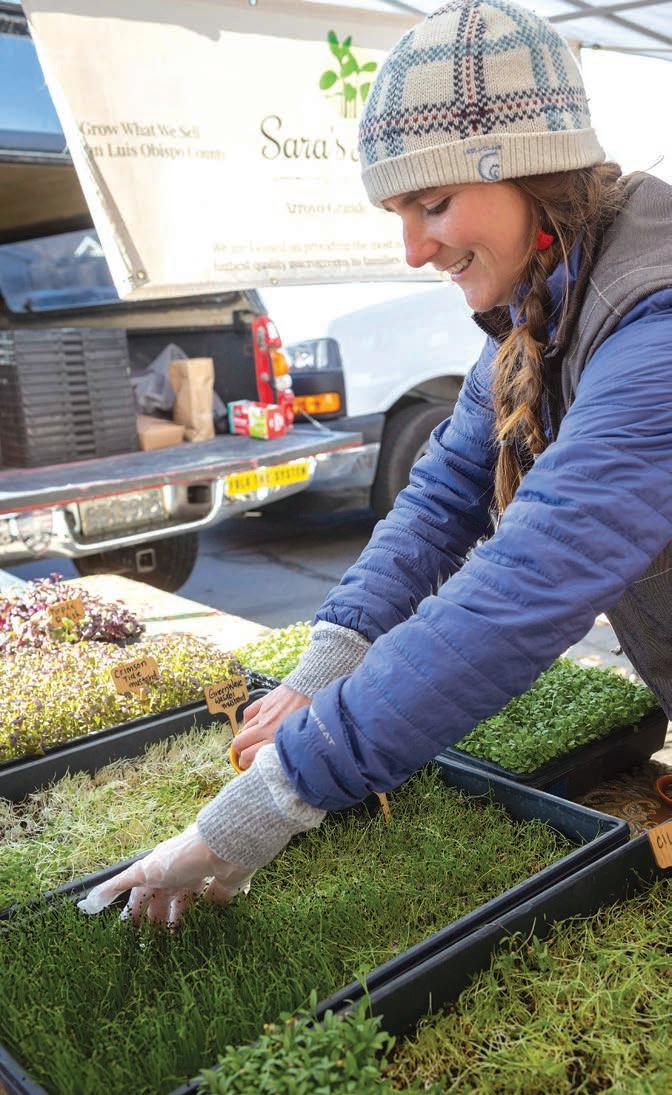

reservations, please visit our website at
reservations, please visit our website at www.ponopacifickitchen.com www.ponopacifickitchen.com






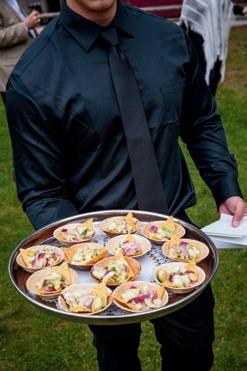


By Aja Goare :: Illustration by Dyna Beach

nyone who has engaged in debate about bagels (given that this is a food magazine, it’s assumed such an argument is relatable) has found themselves on one of two sides: New York bagels are either superior or they’re not. The reason, Big Apple believers argue, is the water.
“Very little water goes into a bagel,” contests Brenda Hock, a San Luis Obispo cooking instructor who has made her share of the round bread. “It’s more to do with the oven than the water.”
Water is important, though. Notably, the bagel is the only type of bread that is boiled in water before it’s baked. This process not only sets the crust to prevent excessive rise during the baking process, but it also gives the bagel its glossy finish. The reason the oven is important, Brenda says, is that a really high, consistent heat produces the best results.
Brenda has been making bagels for decades,
including the 25 years she taught breadmaking. Before making bread, she was dealing with a different kind of “dough” as a bond trader on Wall Street. After she was laid off, she took up cooking school and went on to be a restaurant reviewer in Poughkeepsie, where her love of eating inspired a desire to learn to bake. “I gifted myself bread baking classes at the Culinary Institute of America, then I attended a bread camp in San Francisco,” she explains.
Years later in 1999, after some time running a catering business, a leap of faith brought her to San Luis Obispo. As a member of two local synagogues, Brenda wanted to help bring in extra money to her place of worship in a feasible way. So, she hosted a baking class on site to teach, where congregants could pay to learn bagel, bialy (a traditional bread roll) and babka (a sweet braided bread) baking basics. The money went back into the synagogue. “I feel a strong connection to traditions,” says Brenda. “Judaism has a deep connection to food and hospitality.”


Bagels have long been associated with the Jewish culture. Among the first mentions of them was in Poland in the 17th century. Common lore has it that the bagel was born in response to antisemitic laws that prohibited Jews from baking. “Boiling the bread was a kind of loophole,” Brenda explains. When Jews immigrated to America, they brought the bagel with them. By the early 1900s, there were over 70 bagel shops in New York City. Today, there are an estimated 500 and counting.
Growing up Jewish in New York, Brenda says bagels were an undeniable pleasure for all ages. “When I was younger, I remember people going out late Saturday night to get a copy of The New York Times. They’d stop at the bagel place — we called them ‘appetizer stores’ then — and get a bagel with shmear,” recalls Brenda. “It was a real treat.”
When she makes the coveted provisions today, it’s not without some serious reflection on her last half-century consuming them. One of the biggest influences on flavor, she’s learned, is not an ingredient at all. “Time equals taste,” she shares. “The more time you take, the more flavor is imparted into it.” To this end, Brenda allows her dough to rest overnight. She takes a golf ball-size piece of dough and puts it in a Mason jar full of water. Once the ball rises to the top, it’s time for refrigeration. These steps ultimately give the bagel its signature New York chewiness.
The techniques are countless and vary from city to city and kitchen to kitchen. New Yorkers boil their bagels, but in Chicago, steam produces a fluffy interior; in Montreal, the bagel is thinner, sweeter and denser than its stateside brethren. Even in Poland, the bagel’s presumed birthplace, the obwarzanek krakowski is a braided, ringshaped bread that’s boiled and sprinkled with salt and seeds (sesame or poppy) before it’s baked.
“Sometimes I like to scoop out the soft underbelly and just have the crust with cottage cheese, salmon and chopped tomato,” says Brenda.
In this modern age, bagels are even made gluten free. Salty Bagel in San Luis Obispo, for instance, makes a dozen flavors of bagel all without gluten. And that’s no small feat, considering bagel recipes tend to call for high gluten flour that can more easily produce the traditional texture and chew.
Whether it’s boiled or steamed, made with or without glutenous flour, topped with lox or cream cheese, the bagel is a beloved bite to eat. It’s what Brenda calls the “great bonder.”
“It brings people together and starts the conversation,” she says.










































By Christian Camacho ::




Creatures of habit, many of us divvy up our time between two main locations — home and work, our “first” and “second” places, respectively. These classifications, according to sociologist Ray Oldenburg, are rounded out by a “third place,” a public location outside of home and work where one can socialize and engage with their community. With the development of Duncan Alley on Broad Street in San Luis Obispo, Damien Mavis hopes to offer the community its third place.
Damien moved to San Luis Obispo in 1993 to receive his degree in mechanical engineering from Cal Poly. The Co-founder of CoVelop Inc., he has completed numerous development projects across the county. After building the Creamery Marketplace in Downtown SLO, Damien and his team turned their talents toward an area they felt deserved more attention.


“There are about a thousand homes within a short walk of [Duncan Alley], but this area really didn’t have an authentic third place where people could come and hang out,” he explains. His team thought giving the property the right facelift might turn things around.
Since its development just a few years ago, Duncan Alley has been home to businesses established by locals, for locals. The collective of food and beverage owners helped turn a dilapidated business park into a warm, inviting social nest. The once cold, industrial walls of this concrete complex are now alive with the glow of the incandescent lights in quaint,
refined tasting rooms. The goal was not just a place for people to sip and savor, but also an interactive and authentic experience. “You could be sipping on a glass of wine and probably be talking to the winemaker who served it to you,” says Damien. “And if you have any questions, they might be able to just walk you into the back and show you how it was made.”
Coby Parker-Garcia remembers coming to Duncan Alley as a child with his parents to pick up paint supplies from Warnes Paint. He now operates El Lugar Wines in the same space that used to house rows of color palettes. The tasting room is decorated with plants curated by his wife, Katie Noonan, who both assists with operations and works as a florist. Meanwhile, Coby maintains the barrel room and production facility in back.



“The cider, in the first place, is really good,” she says. “It’s just a nice time during the week to see my friends. That’s kind of my favorite thing about it. I see them on the weekends and everything, which is fun, but it’s also cool to have a time in the middle of our schedules to all hang out.”
The character of El Lugar, which in Spanish translates to “the place,” pays homage to Coby’s MexicanAmerican heritage and is displayed on the walls of the former paint store, like an exhibit in a museum. “We don’t own any vineyards, so it’s kind of easy to tell our story,” Coby says.
Their story is just one of many to be taken in at Duncan Alley, where each vendor brings something new to the proverbial table. “It’s neat because each space is so different, right? It’s people’s own little personality, which is cool,” Coby explains. “All the owners are great people. They’re relatively young entrepreneurs. This is their business; this is their livelihood.”
The rising cost of rent downtown can stop new businesses from ever starting. But Tommy Valois, Co-founder of Shindig Cider, says the affordable rent here has made it possible for small businesses like his to get off the ground. And the flow of business is strong. The Duncan Alley community frequently collaborates with local food and art vendors, hosting recurring events for those looking for a weekly, consistent watering hole.
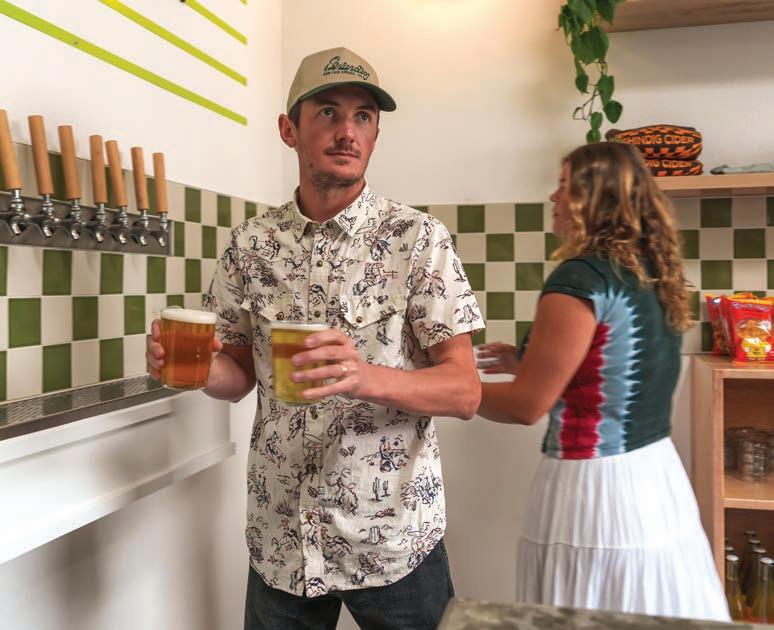
Keara McCall is one such regular. Tuesdays find Keara and her friends teaming up for trivia night at Shindig, where they enjoy Mexican food from the Taco Tuesday vendor posted at Ancient Owl Beer Garden and Bottle Shoppe. In her search for a fun, yet challenging way to test her knowledge off campus, Keara has found a spot to call her own.
A bona fide third place may be easily associated with a place to grab an adult beverage, but Duncan Alley also has space for fitness and sober aspirations. In a single visit, one could enjoy a meal after a Pilates or yoga class at Ritual Reform or Ivory Yoga. Locals flock to the KBRG Coffee Lab, the latest coffee shop from the Poor But Sexy project, for their morning or afternoon caffeine fix. From meeting up with friends for coffee or a drink, to working on fitness and spiritual goals, this collaborative of vendors offers a full day of experiences under one roof.



By Katy Budge :: Photography by Ruby Wallau
he town of Cayucos has been a prime vacation destination for decades, and for many good reasons. With a population just shy of 2,400, it truly is one of the last small California beach towns. It enjoys a serene seaside location surrounded by rolling hills and ranch land. Its temperate weather encourages a myriad of outdoor activities.
It also exudes an authentic charm, thanks in part to the iconic pier that serves as the town’s focal point. And Cayucos draws throngs of visitors throughout the year for time-honored traditions such as the Fourth of July celebration, Antique Street Faires and even the New Year’s Day Polar Dip in the chilly Pacific Ocean.
To add to its allure, Cayucos has a robust food scene for such a small town. Each restaurant seems to have found its own little niche. When it comes to ambience, an ocean view is rivaled only by a peaceful garden atmosphere. Food options run the gamut from Mexican food to gluten-free blue corn waffles, fresh donuts or a steaming cup of cappuccino, award-winning clam chowder or nationally recognized brown butter cookies.


Much of Cayucos has remained the same since the pier was built in 1872, but a lot has changed — change that admittedly has included some growing pains. As is the case with much of coastal California, Cayucos is subject to the modern pressures of short-term rentals and rising real estate prices. According to Zillow, an online real estate marketplace, the average home cost in Cayucos is higher than in Morro Bay, San Luis Obispo, Monterey and even San Diego.
But is Cayucos really on its way to “becoming a ghost town” as stated in a recent Los Angeles Times article? It alleged that the transformation of homes into vacation rentals has left the town deserted through the off season. The way many longtime business owners here see it, ghost town claims would be something of a fish tale — highly exaggerated.
“The heartbeat of our town is still really strong thanks to the support of our community,” Jeniece Grimshaw observes. A San Luis Obispo County resident since 2014 and a graduate of Le Cordon Bleu culinary school, she opened her Bijou Bakery at the north end of Cayucos in 2020. It quickly gained a following for her wide variety of French-inspired pastry items.
Jeniece’s positive sentiment about the town is echoed by many in the local restaurant industry.

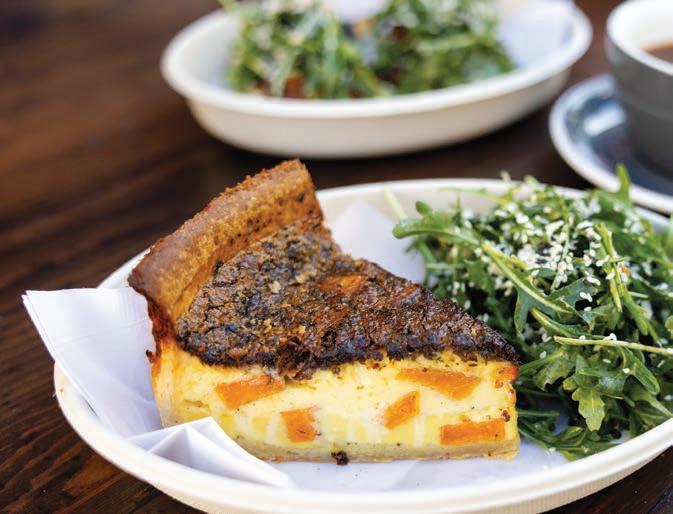

Like most scenic, charming California towns, Cayucos has traditionally depended on tourism, but tourists come and go.
“We’ve always had a falloff as summer ends, and sometimes in December it almost is a ghost town,” notes Carol Kramer, who has owned the Sea Shanty restaurant with husband Bill Shea since 1983. The casual, buzzy restaurant serves up hearty meals, but those in the know will save room for desserts such as fruit pies, chocolate mousse and The Kitchen Sink sundae.
Over the four decades that Carol and Bill have lived in Cayucos, they’ve experienced a lot of transitions. “We’ve seen all the ups and downs, but we’ve always been very supported by local people,” she says. “This last summer was busy with a lot of young families visiting.”

No doubt many of those families were staying in vacation rentals. But rather than be a harm to local industry, Carol believes it fills a need. “We really don’t have enough hotels to meet demand, so those actually help pick up some of that slack,” she says.
It’s true that short-term rentals aren’t occupied year-round, but “Cayucos has always had a vacation aspect, and it’s still a very seasonal town,” says Schooners Wharf Owner Brendan Fritzsche. His nautical-themed restaurant is one of the town’s more popular spots, in part thanks to its full bar and its scenic perch above the historic pier and expansive beachfront.
For Brendan, the market presented an opportunity, and he recently added four vacation rentals to his business portfolio. “The building next to us used to be a motel, so it seemed natural to go in that direction,” he explains.
Perhaps because of its enduring appeal, or its relative proximity to California’s major cities, Cayucos has a lot of repeat customers. As such, a case could be made that vacationers who return year after year have come to be considered “locals” by some businesses.
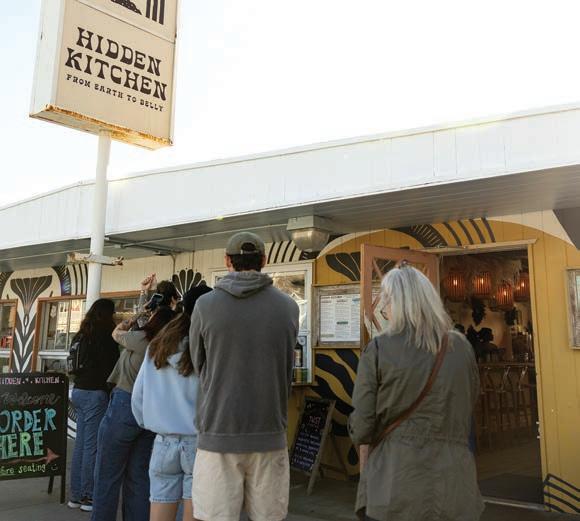
“We have a lot of out-of-town regulars that have become like family,” says Juneé Sherwood, who runs Cayucos Sausage Company with husband Don Sherwood. “They’ll come in and say, ‘We’re back!’ and get all their favorites.” And, because the business is also a butcher shop, many folks staying in vacation rentals will grab something to throw on the grill.
If Cayucos does seem a bit sleepy of late, Juneé points out a couple of factors that have adversely affected the town. The off-and-on shutdowns of Highway 1 have throttled the number of tourists passing through, but perhaps more impactful was the 2016 shuttering of the Cayucos Veterans Hall due to structural and safety concerns. Situated at the end of the picturesque pier, the historic hall acted as a community gathering place for everything from weddings to the popular Sea Glass Festival. The opening of the restored and redesigned building this year is expected to provide a big boost to local businesses.


That Cayucos has survived these recent ups and downs — including the pandemic — proves this is a resilient community.
“Of course Cayucos has its slow seasons, like any beach town, but we have a fierce local base that keeps it going through those seasons,” says Ellen Sizemore, who recently opened the pier-side Pie in the Sky Pizza with her husband Jeremy Sizemore. (He co-owns Spearhead Coffee in Paso Robles; he and Ellen also own High Tide in Morro Bay.)
Ellen adds that, like themselves, most Cayucos business owners live in town. “We have a really good camaraderie between all of us,” she says, adding that as locals, “we obviously care deeply about this town and want to protect its character.”
Like any town, there’s an ebb and flow to the Cayucos commercial landscape. Stalwarts such as the hardware store have closed, and the treasured Old Cayucos Tavern & Card Room only opens intermittently. However, new businesses have recently opened their doors, such as a makers’ gallery and a skin care studio featuring locally crafted products. “Change is inevitable, and not always a bad thing,” notes Jeniece.
She, like Ellen, stressed the importance of civic support. “Probably a third of my bakery clientele are dedicated regulars,” she says. And she notes that referrals from other businesses are the norm in Cayucos, perhaps because there’s remarkably little overlap on menus in town.
“There’s just a really symbiotic relationship with all the business owners,” Jeniece says. “We really uplift and inspire each other, and have a real interest in keeping this community strong.”

























By Jonathan LaFerrara :: Photography by Sarah Kathleen




There was a time when San Luis Obispo County had the “biggest Mardi Gras celebration west of the Mississippi.” That was until 2004, when the event, involving over 10,000 tourists, devolved into riots. Police officers cleared the area using pepper bullets, bean bag rounds and tear gas. Revelers reacted by throwing rocks, bottles and firecrackers. Cars were rolled over, and stop signs used as shields. More than 180 arrests were made in one evening and the city called in $100,000 worth of extra police help.


In following years, the City of San Luis Obispo pushed forth “The Party is Over” marketing campaign to deter potential visitors from coming to the area for Mardi Gras. Fines for public disorder incidents tripled. What started as a small, local parade in the 1970s was no more.
What remains of the festivities today in San Luis Obispo can be experienced year-round. Founded in 1995, Bon Temps Creole Café offers the Cajun Creole cuisine that’s essential to Mardi Gras. “Cajun food is an exciting cuisine for me. It’s French cooking, basically, but with a lot more spice and pizzazz,” says Owner Phil Lang.
Cajun and Creole fare overlap; both are Southern-based cuisines developed from a French culture and cooking techniques. Creole cuisine comes from descendants of the upper-class French and Spanish settlers, while Cajun cuisine is traced back to French-Canadian descendants, who arrived in Louisiana after years of suffering and exile. Many New Orleans restaurants serve food inspired by both. There are often Creole and Cajun versions of the same dish — rich gumbo, smoky jambalaya and smothering étouffée.
Bon Temps was first opened on Olive Street, across the freeway from its current location. A second spot was opened in Pismo Beach. Later Phil and Co-founder Bob Winick split the restaurants, with Phil and his wife Julie, taking on full ownership of the San Luis Obispo location. Eventually, the Pismo Beach restaurant closed.
The journey of Bon Temps has come with its share of challenges, sourcing specialty ingredients and balancing tradition with local tastes, among others. They also included a big move with an intricate facelift. The restaurant now

stands in the city’s Railroad District in historic Hotel Park, which is over 100 years old. In 1983 the building underwent a $1 million complete remodel with two floors converted into apartments and the ground level reserved for restaurants.
“I love the area,” says Phil. “Just the vibe of it all. Having the patio that we do, it feels like going to a Garden District restaurant or hotel in New Orleans.” Here, customers feast on popular dishes including eggs Sardou (poached eggs in artichokes, topped with a spinach garlic cream sauce), faitdodo (a skillet of red beans and grits, covered with eggs and hollandaise sauce and served with andouille sausage) and shrimp and andouille jambalaya (made with a spicy Creole sauce and white rice, served with cornbread and honey butter).
The café isn’t just a place for food. It’s a celebration of the lively Creole culture, with zydeco music and Southern staples, and an invitation to savor the spirit of the South. At a time when restaurant industry turnover is the norm, it is one of the few places where loyalty and longevity define the staff, adding depth to the dining experience. Phil’s Co-Chef Martín Zarate has been here for 17 of the restaurant’s 29 years; Martín’s wife, Antonia, is the prep cook and has worked here for 15 years.


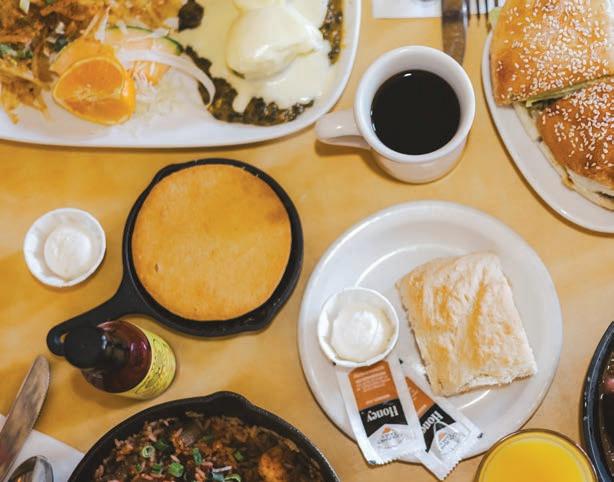
This dedication has fostered an atmosphere of charm, rhythm and reliability. Gary Laver, a professor at Cal Poly and regular customer, finds himself dining here five or six times a week. “I’ve been going here for at least two decades,” he says. “Back in the day, I went there only for lunch on Thursdays. I now eat there far more regularly, but Thursdays soon came to include lunch with friends from work. [My family] has celebrated many special occasions there. When I’m by myself it’s a place to get comfortable and read. I also like the jazz or blues they play in the background. I can’t think of any other place in town that can tick all those boxes for me.”

Despite any challenges, catering to an audience that’s 2,000 miles away from New Orleans and sometimes unfamiliar with traditional Creole dishes has its rewards. The restaurant has become a culinary landmark, where students celebrate milestones over muffulettas (traditional New Orleans sandwiches with sliced capicola, salami, ham, provolone cheese, olive tapenade, lettuce, tomatoes, pickles and a Creole aioli) and locals find an unexpected taste of the South. The blend of hardy, flavorful dishes with a welcoming atmosphere has made this restaurant not just a place to eat, but also a place to connect and savor a bit of Louisiana “esprit” — no matter the zip code.

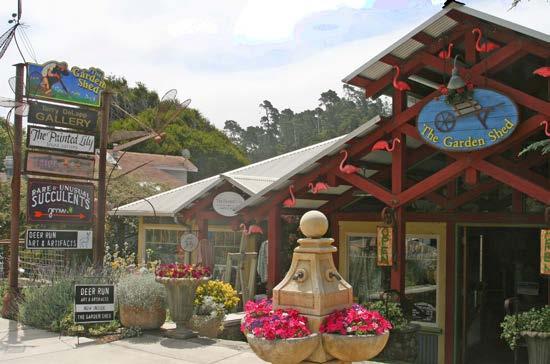













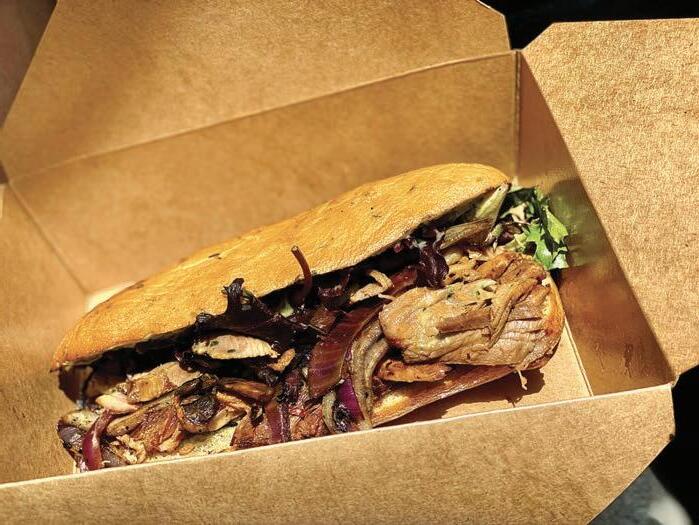

















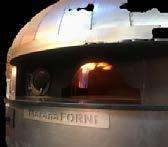








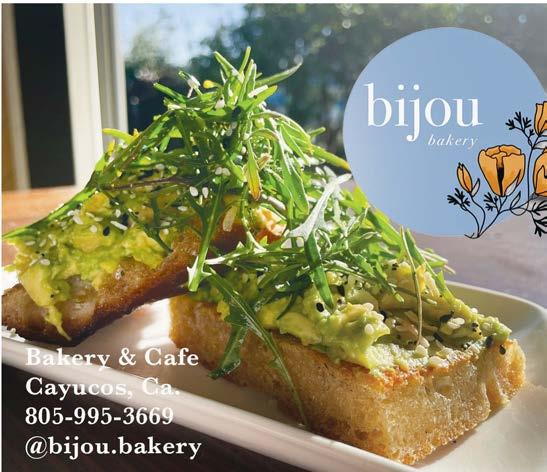


Etto Pasta Cookbook. $30 ediblesanluisobispo.com/cookbooks-etto

When we at Edible started getting serious about publishing cookbooks, we knew we had to start with Etto Pastificio. It’s this pasta that has influenced so many dishes found in restaurants throughout California — and on dinner plates in homes. But it’s really the people at Etto, with their natural ability to make cooking feel simple and heartfelt, who inspire us to cook their way. Enjoy this excerpt from the book.
Recipe by Brian Terrizzi :: Photography by Richard Fusillo
Aglio and olio are what some consider to be the original pasta sauce, and it’s also a fairly obscure record from the Beastie Boys. This sauce is the start of what becomes many more complex sauces so it can be hard to stop with just the basic two ingredients the dish requires. Many recipes add pepper flakes, black pepper,
cheese and parsley to finish it; we chose crispy capers here. Restraint and simplicity are the order of the day for this one, and with our great tasting pasta, sauce is hardly needed at all (no modesty here — we sample our unadorned pasta nearly every day in the factory for quality control).

Serves 4-6 | Cook time 15 minutes
1 cup extra virgin olive oil
4 tablespoons capers, drained and patted dry
1 pound dried Etto pasta
5 tablespoons finely chopped garlic
2 medium shallots, minced 1-2 teaspoons Calabrian chili flakes, using more or less to taste
¾ cup grated Parmesan cheese, plus more for serving
4 tablespoons chopped Italian parsley, plus more for serving Kosher salt
STEP 1
In large skillet or wok, heat olive oil over medium heat. Add capers and fry gently until crispy, being careful not to overheat and burn oil. Remove from oil with a slotted spoon and set aside until serving time, leaving olive oil in pan
STEP 2
In large pot, bring 4 quarts of water to a boil and add 1-2 tablespoons salt. Cook pasta to al dente according to package instructions. Drain pasta, reserving about 1 cup starchy pasta water.
STEP 3
Return skillet to medium heat with reserved olive oil. Add garlic, shallots and chili flakes. Cook until fragrant, taking care not to burn garlic, about 60 seconds. Add cooked pasta to pan and mix thoroughly to coat pasta with seasoned oil. Add about ⅓ cup of reserved pasta water and allow to simmer until a creamy sauce begins to form. Remove from heat. Add cheese and parsley. Stir to combine, adding more pasta water as needed to maintain a creamy sauce. Season with salt to taste, if needed (the capers are salty).
STEP 4
Divide into warm bowls and finish with cheese, parsley and the fried capers.

I discovered this spine-tingling vodkatini at London’s popular Taiwanese diner BAO. You must use Chinese red vinegar for the pickle, to get that Far Eastern sweet and spicy flavor. The pickled radish garnish adds an electric-pink pop and a flare of rootsy fire.
Makes 6 cocktails
Measurements converted from milliliters
INGREDIENTS
10 ounces Haku vodka
1 ounce Cocchi dry vermouth
1 ounce radish pickling liquid (recipe below)
6 pickled radishes for garnish (recipe below)
PREPARATION
Combine all ingredients with ice in shaker and shake. Strain contents into 6 cocktail glasses and garnish each with a pickled radish.
INGREDIENTS
2 cups red radishes, cleaned and trimmed
2 ounces Chinese red vinegar
1¾ tablespoons caster sugar
Pinch of salt
½ long red chili
PREPARATION
Combine all ingredients in jar. Leave to infuse for at least 24 hours before using. Store in fridge.



